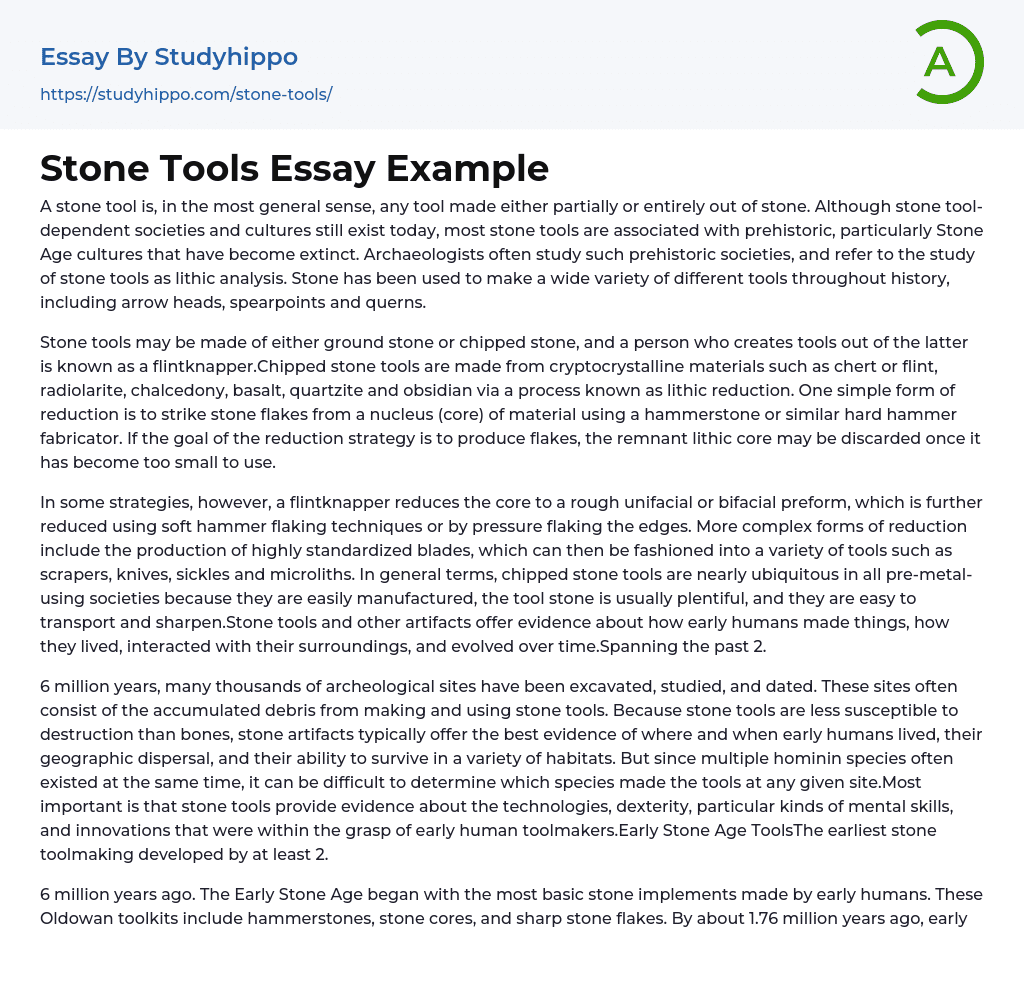A stone tool is, in the most general sense, any tool made either partially or entirely out of stone. Although stone tool-dependent societies and cultures still exist today, most stone tools are associated with prehistoric, particularly Stone Age cultures that have become extinct. Archaeologists often study such prehistoric societies, and refer to the study of stone tools as lithic analysis. Stone has been used to make a wide variety of different tools throughout history, including arrow heads, spearpoints and querns.
Stone tools may be made of either ground stone or chipped stone, and a person who creates tools out of the latter is known as a flintknapper.Chipped stone tools are made from cryptocrystalline materials such as chert or flint, radiolarite, chalcedony, basalt, quartzite and obsidian via a process known as lithic reduction. One simple form of red
...uction is to strike stone flakes from a nucleus (core) of material using a hammerstone or similar hard hammer fabricator. If the goal of the reduction strategy is to produce flakes, the remnant lithic core may be discarded once it has become too small to use.
In some strategies, however, a flintknapper reduces the core to a rough unifacial or bifacial preform, which is further reduced using soft hammer flaking techniques or by pressure flaking the edges. More complex forms of reduction include the production of highly standardized blades, which can then be fashioned into a variety of tools such as scrapers, knives, sickles and microliths. In general terms, chipped stone tools are nearly ubiquitous in all pre-metal-using societies because they are easily manufactured, the tool stone is usually plentiful, and they are easy to transport and sharpen.Stone tools and
other artifacts offer evidence about how early humans made things, how they lived, interacted with their surroundings, and evolved over time.Spanning the past 2.
6 million years, many thousands of archeological sites have been excavated, studied, and dated. These sites often consist of the accumulated debris from making and using stone tools. Because stone tools are less susceptible to destruction than bones, stone artifacts typically offer the best evidence of where and when early humans lived, their geographic dispersal, and their ability to survive in a variety of habitats. But since multiple hominin species often existed at the same time, it can be difficult to determine which species made the tools at any given site.Most important is that stone tools provide evidence about the technologies, dexterity, particular kinds of mental skills, and innovations that were within the grasp of early human toolmakers.Early Stone Age ToolsThe earliest stone toolmaking developed by at least 2.
6 million years ago. The Early Stone Age began with the most basic stone implements made by early humans. These Oldowan toolkits include hammerstones, stone cores, and sharp stone flakes. By about 1.76 million years ago, early humans began to make Acheulean handaxes and other large cutting tools. Explore some examples of Early Stone Age tools.
Middle Stone Age ToolsBy 200,000 years ago, the pace of innovation in stone technology began to accelerate. Middle Stone Age toolkits included points, which could be hafted on to shafts to make spears; stone awls, which could have been used to perforate hides; and scrapers that were useful in preparing hide, wood, and other materials. Explore some examples of Middle Stone Age tools.Later Stone Age ToolsDuring the Later Stone
Age, the pace of innovations rose.
People experimented with diverse raw materials (bone, ivory, and antler, as well as stone), the level of craftsmanship increased, and different groups sought their own distinct cultural identity and adopted their own ways of making things. Explore some examples of Later Stone Age tools.ConclusionThe time after the Stone Age is the Bronze Age, named after the metal bronze. The Stone Age ended when people discovered the art of smelting (making metals). The first metal was copper, followed by bronze.
People probably began using bronze instead of just stone in the Middle East sometime between 3000 and 2000 BC.The Palaeolithic is a prehistoric era distinguished by the development of stone tools. It covers the greatest portion of humanity's time on Earth, from about 2.7 million years ago to about 20,000 years ago. It was followed by the Mesolithic and Neolithic cultures.
- Ranch essays
- Culture essays
- Social Control essays
- Citizenship essays
- Social Justice essays
- Caste System essays
- Social Responsibility essays
- Socialization essays
- Deviance essays
- Modern Society essays
- Popularity essays
- Civil Society essays
- Community essays
- Female essays
- Filipino People essays
- Igbo People essays
- Indigenous Australians essays
- Indigenous Peoples essays
- Minority Group essays
- Social Institution essays
- Men essays
- The nation essays
- Middle Class essays
- Social Norms essays
- Discourse Community essays
- Popular Culture essays
- Car Culture essays
- American Culture essays
- Mormon essays
- Indian Culture essays
- Mexican Culture essays
- Pop Culture essays
- Cultural Differences essays
- Culture Shock essays
- Different Cultures essays
- Agriculture essays
- Albert einstein essays
- Animals essays
- Archaeology essays
- Bear essays
- Biology essays
- Birds essays
- Butterfly essays
- Cat essays
- Charles Darwin essays
- Chemistry essays
- Dinosaur essays
- Discovery essays
- Dolphin essays
- Elephant essays




